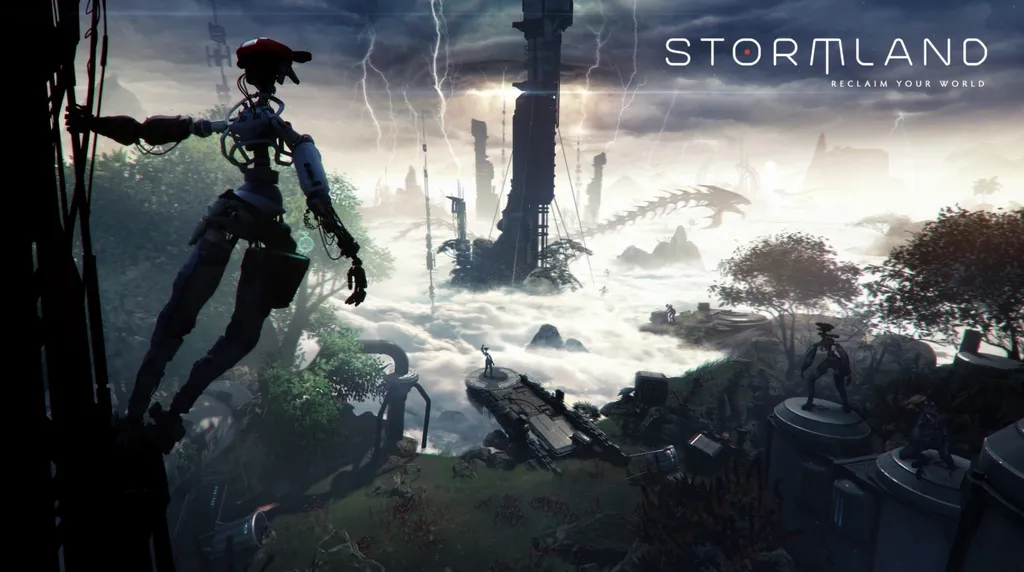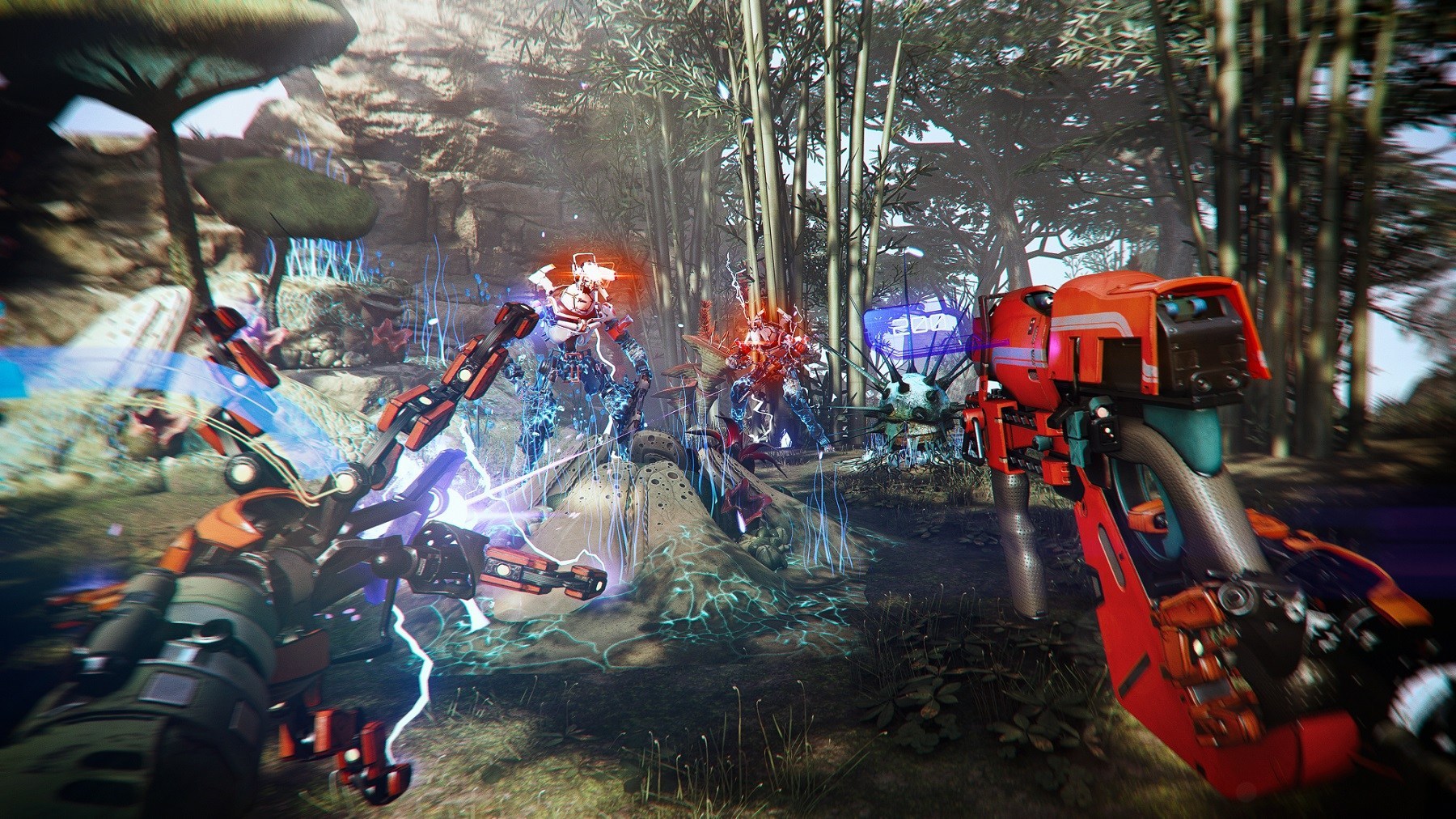Brimming with features, boasting infinite hours of play, and unrivaled in visual polish, Stormland is as slick a VR shooter as you can find right now.
It’s a burgeoning game that, at its best, glides straight over the competition’s head before sliding into a slipstream and leaving them in the dust. It is the yard stick to show you how far the VR FPS has come in the past three years, but also how much further it has to go.
Insomniac’s latest is easily its most ambitious VR project yet. As such, there’s a lot to explain here. Stormland offers a set of sprawling open-world maps, dotted with tiny, lavishly-produced islands you reach by skimming across an ocean of clouds. You embody a robot that takes the fight to a hostile army of machines known as The Tempest which often guard objective markers with a watchful eye. Your first four or five hours with the game will be spent learning the ropes, upgrading your body to get into fighting shape and establishing a base of operations as you move up through three layers of the Stormland, each harder than the last.
After that, though, the game shows its true colors.
See, Stormland isn’t your traditional story-driven shooter. After that extended tutorial the world essentially resets itself and you have to make your way back to the top to take down a facility called Terminus. This time, however, you’ll be given a different set of missions and side-objectives, each layer of the Stormland is redesigned and, more importantly, you have a time limit. Every time you take down Terminus you can start over with harder enemies and better equipment. But every week on Tuesday morning around 9AM PT, the Stormland resets and you’ll find a new(ish) world to explore and shoot your way through, often with new conditions that might make enemies tougher or greater in number. Not only that, but you’ll be able to respec your upgrades each cycle.
In many cases, this would sound like endgame content, but it’s important to make the distinction that, in Stormland, this is the game. Insomniac’s admittedly ingenious remedy for the trials of making a meaty VR shooter isn’t to pad out an exhaustive campaign but instead regularly revitalize a more manageable set of levels. You’ll see the same assets and such used again, but the idea is to make Stormland a persistent go-to for VR action either for yourself or, preferably, with a friend in two-player co-op. Dry spell in VR releases one week? Not to worry; there’s always Stormland.
This is a sprawling shooter, but a recycled one. You’ll have seen much of what it has to offer visually within those opening hours; it’s just a case of approaching it all again in ever-varying shades. It is, by its very nature, a repetitive game, driven by your own desire to upgrade and expand. But that cycle has rhythm; a beaten path so moreish to follow and a set of mechanics so meticulously refined that the tedium of reliving the same game never really sets in, especially when playing with friends.
Though you can trace much of its design back to traditional console games (including a surprising set of similarities to Insomniac’s Ratchet and Clank series), everything in the game has been thoroughly sifted through a VR filter with painstaking scrutiny to allow almost unprecedented freedom in how you approach most objectives. Each weapon for example, can be held in one hand but, to make them more accurate, they’ll extend their grip if you grab it with your free hand. It’s a mostly seamless transition that makes for one of the smoothest shooting experiences I’ve had in VR.
[vc_row][vc_column][vc_cta h2=””]Comfort
Stormland is an undeniably intense VR experience with fast smooth locomotion, gliding and flying. It will be a lot for people prone to simulation sickness to stomach, but there are options to offset this. You can add a vignette, change the speed at which you start walking and change turn styles. There’s no getting around the smooth locomotion, though, so keep that in mind before you make a purchase.[/vc_cta][/vc_column][/vc_row][vc_row][vc_column][vc_column_text]
Crucially, though, every island allows you to clamber all over with VR’s tried and true climbing mechanics and, when in the air, you’re able to slowly descend based on the direction in which you’re pointing your arms. This is truly a 360-degree shooter, allowing you to attack from any angle you see fit. Sometimes I’d be hoisting myself up over a ledge with one hand to take pot shots with the other. Sometimes I’d be raining down death from above as I hovered overhead. The versatility on offer here is nothing short of impressive and it often makes for empowering play. You may essentially be a Terminator, but I kept coming back to Rambo when considering how to approach the next encounter.
The trouble is that the game’s enemies struggle to keep pace with your military superiority. Easily Stormland’s biggest problem is the enemy AI, which wrestles with its open-world ambitions throughout. I’d fairly consistently see sentries trying to walk through walls or, more worryingly, appear absolutely oblivious to my presence when the guard standing right next to them was opening fire. There’s no faster way to break immersion than to see what’s meant to be a threat stumbling over so often, and it can rob a lot of encounters of the cinematic intensity Insomniac was clearly gunning for. It’s a shame given the lengths the developer has gone to maintain immersion elsewhere.
In fact, every interaction in Stormland has been approached to reduce VR’s tinge of awkwardness, at least as much as possible. Activating menus and maps on your left hand is wonderfully intuitive thanks to a Lone Echo-style holographic UI. Need to set a waypoint on your 3D map? Just… touch that point and you’re good to go. What about the oh-so-sticky VR shooter pain point that is reloading? Simple; Stormland doesn’t have it. Once a gun is out of ammo, you get rid of it (or dismantle it for upgrade parts), pick up another from a dead enemy, and let loose.
Gliding and hovering over the clouds, meanwhile, has a Superman-style (and only slightly humiliating) satisfaction to it when you raise your arms. If Stormland’s lush jungles and erratic wildlife remind you of Nintendo’s Metroid series (or, more specifically, Metroid Prime), then surfing on clouds to jet between islands carries the breezy enlightenment of sailing the oceans in The Legend of Zelda: The Wind Waker.
For all it’s many triumphs, though, Stormland still has plenty of reminders of just how hard it is to make a fully immersive, AAA shooter. While the controls remove much of the overwhelming fluster of other VR games, they’re not perfect. I’d get irritated by the constant vibrating of my touch controllers when my hands approached my weapon holsters even if I was just dropping my arms. To make matters worse, I’d often go to grab my guns, but my hands instead grabbed the ground as if I were climbing a wall. When I wanted to hold a minigun with both hands, there was a 50/50 chance I’d accidentally grab the end of the gun to dismantle it instead. When you’re experiencing these hiccups in the heat of combat, Stormland can be a really frustrating game.
I also had problems completing objectives in the game once I entered the main component. Sometimes I’d get missions I was told would be marked on my map, but I couldn’t find them anywhere. At other points I had, as far as I could tell, done what an objective was asking me to do, but couldn’t seem to progress. It wasn’t until I quit out of the game and returned that these issues fixed themselves. This caused some real road bumps that Insomniac needs to either fix, or provide clearer direction with going forward.
This isn’t as remarkably trouble-free an experience as, say, Asgard’s Wrath, then. But Stormland only runs into these issues because of its incredibly ambitious premise. When it’s not falling over itself, it is an utter delight to play.
There’s plenty more work to be done, then, but when looking back at the shape of VR shooters over the past three years, Stormland shines as a real achievement. Many of its dizzying strands of design are dreamlike in delivery, from the seamless UI and scaling cliff faces with Olympic proficiency to effortlessly surfing its bed of clouds or unloading a rattling barrage of bullets on enemies. Its stumbles are as obvious as they are numerous, but it picks itself back up again time after time. The seas of VR shooter development are still stormy, but Stormland sails them with aplomb.
Final Score: 


 4/5 Stars | Really Good
4/5 Stars | Really Good
Note: We are changing our review scheme to a five-point scale, without half points, rather than a 10-point scale with half points like before. All past reviews will stay as they are, but all future reviews (that includes games, non-game apps, hardware, and more) will all be reviewed using the same five-point star rating scale. Expect the visual representation of this new scale to change with a more attractive style soon.
You can read more about the new scoring policy here.
Stormland releases exclusively on Oculus Home for the Rift platform on November 14th for $39.99.




























